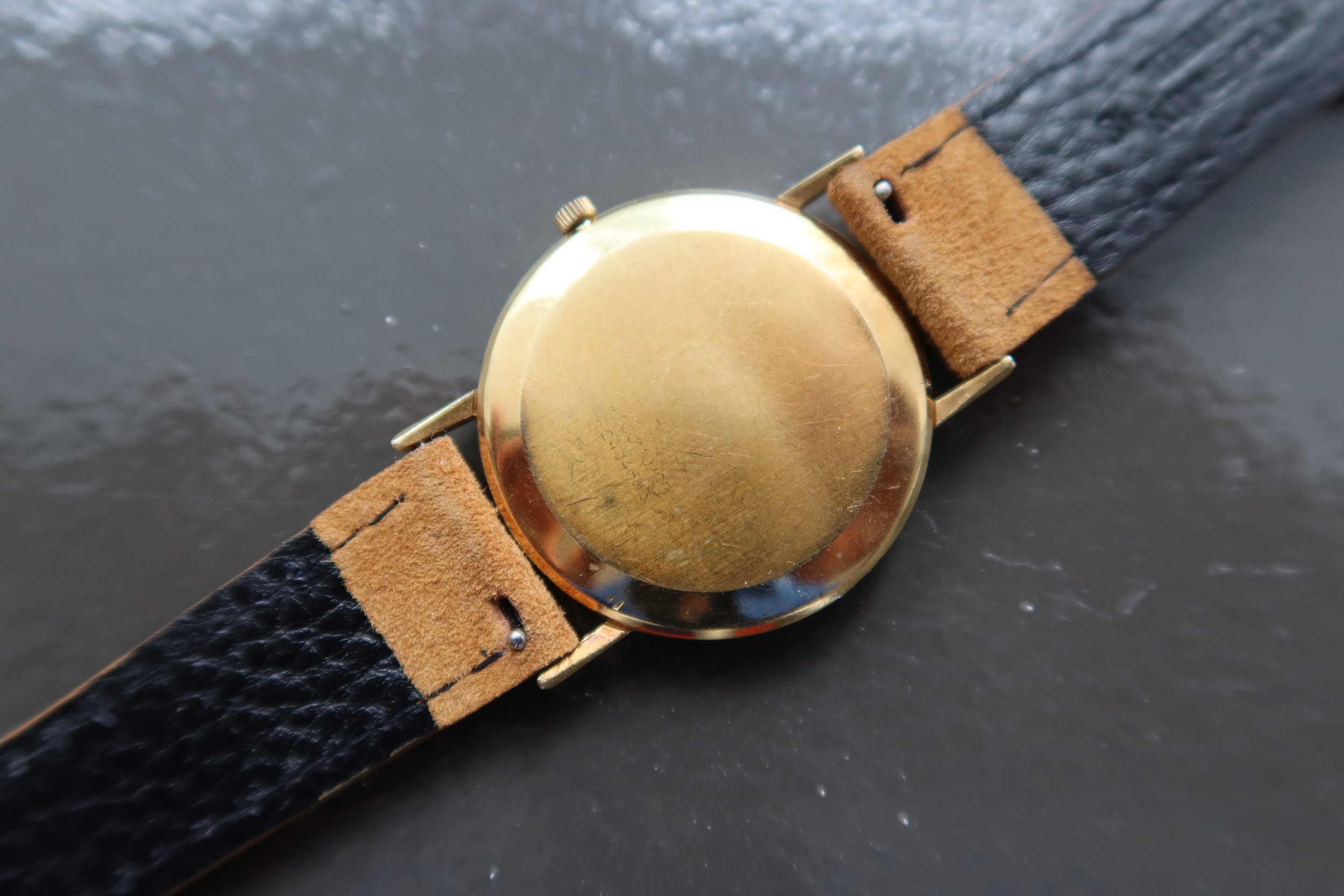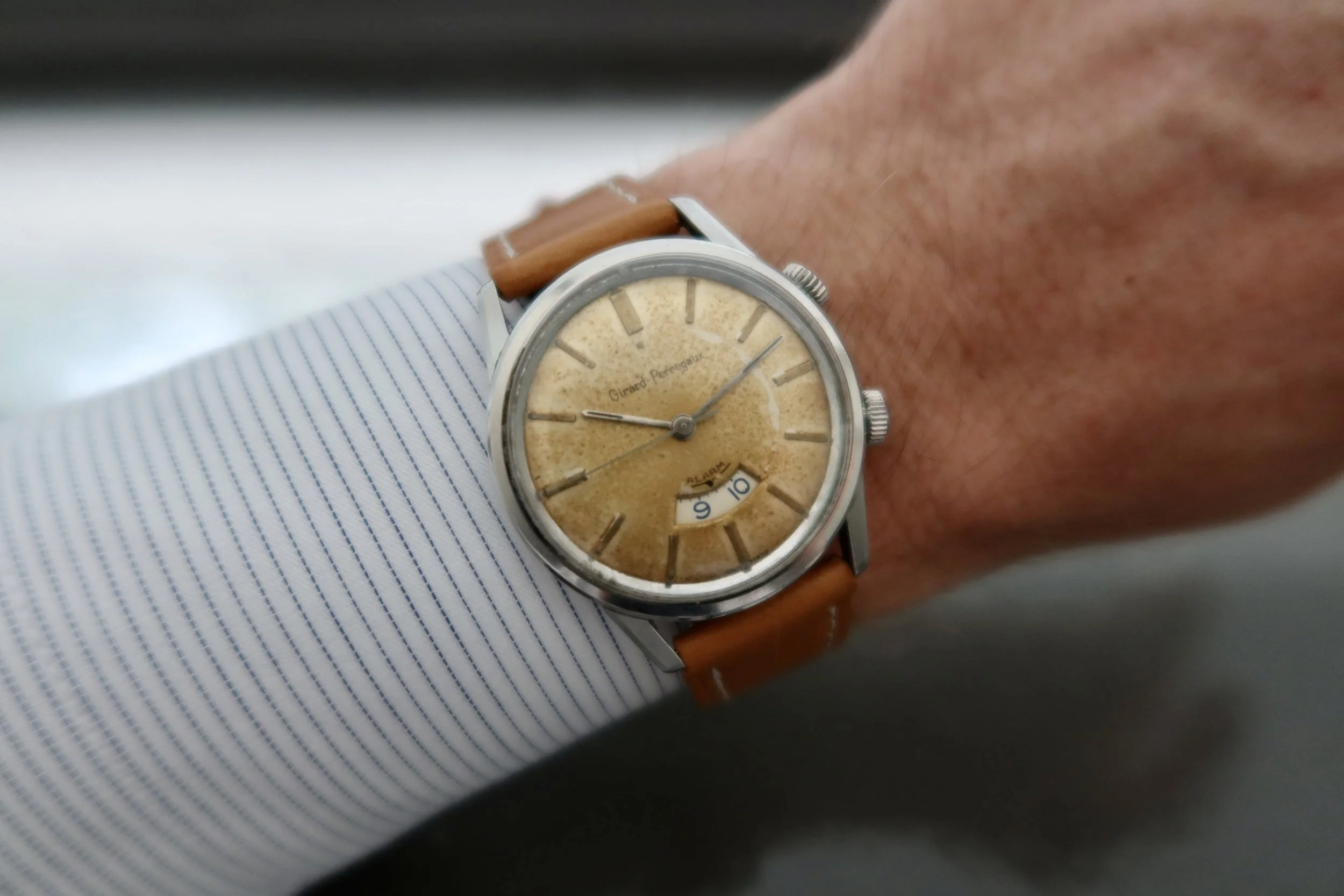The 1965 Universal Genève reference 166110 Golden Shadow
The watch industry, like all product industries, is filled with innovation. But not far behind innovation comes competition. A brand that stood at the forefront of innovation, as well as being a fierce competitor, was Universal Genève. Not only has the brand produced exceptional watches during its history, it also has created products that took first prize in many categories.
Many are aware that in 1955, Universal Genève created the caliber 215 movement. This movement was a new self-winding movement with an oscillating weight integrated into the movement. Commonly, this is called a micro-rotor because essentially the oscillating weight is a smaller version of the rotors that rotated on top of the movement of automatic watches to provide power to the mainspring. The movement was patented by the manufactured and used in many of their watches, the most iconic being the Polerouter, famously designed by Gerald Genta.
An extremely important part of the companies history though, is what they released in 1966 at Baselworld. A perfect watch to tell this story is this Universal Genève Golden Shadow from 1965. After a successful launch of the Polerouter, the manufacture decided there were additional barriers that needed to be pushed from an innovation perspective. So, they released their ‘Shadow’ line of watches - the brands response to the fiercely competitive ultra-thin wrist watch. They had three lines - the White Shadow cased in stainless steel, the Gilt Shadow, cased in gold plated steel, and the Golden Shadow cased in solid gold. These watches, launched in 1965 and debuted in 1966 at Baselworld, were the world's thinnest self-winding watches measuring in at a thickness (if we can call it that!) of 2.3mm. They held the record until 1978 when Lemania introduced the caliber 2100.
This Golden Shadow was one of the originals. The serial number on the case dates to 1965, meaning it was one of the first watches to come out of the watchmaker for the Golden Shadow line. Being a Golden Shadow, it is cased in a round solid yellow gold case that is 34mm in diameter. The lugs are thin and quite long making it sit larger and comfortably on the wrist. The case is in good condition, with the reference number and serial number still visible on the caseback which has some spots of oxidation. Next to the crown, one can still see the hallmark stamp, although it is likely the case has been lightly polished.
The dial of the watch features a plain white background that has aged nicely since the 60’s. It has roman numerals for hour markers which give the watch a dressier feel to it. Like the hour markers, the Universal Genève name, logo, and model type are all printed on the dial as well as ‘automatic’ at 6 o’clock. Golden Shadow’s featured a variety of case designs and dial layouts. Some feature the model name at 6 o’clock but this reference, the 166110 has it below the company name. This is the third series of this reference, with the second and first series having a different dial layout; the “Golden Shadow” and “Automatic” are swapped compared to the third series. Based on serial numbers of first and second series Golden Shadow’s, it seems like the production of each series happened very close to one another, or possibly at the same time.
Before we move on to the movement, there is some interesting research found about the case of the watch. On the caseback, one can find some interesting stamps that tell us more about the watch. Naturally, one sees the Universal Genève logo stamped and the 18k gold stamp. It also has the yellow gold Helvetia stamp, the Swiss hallmark for 18 carat gold. It also features the Geneva key hallmark, with the number 26 inside of it. This indicates that the case was made by Ponti, Gennari & Cie in Geneva.
This Geneva based watchmaker was known for making cases and bracelets for brands like Patek Philippe. Well known casemaker, Jean-Pierre Hagmann, worked for Ponti Gennari. This information points to the fact that the case was created in Switzerland. Furthermore, the movement does not appear to have any import stamps used to import watches to the US market. So, it is likely that the watch was fully created in Switzerland, not sold to the USA market, and probably sold in the European market.
Speaking of the movement, the watch is running on the famous caliber 66 movement. As alluded to previously, this caliber was a record-breaking movement. It was launched in 1966 with the introduction of the Golden Shadow and was the world's thinnest self-winding movement until 1978 measuring in at a thickness of 2.3mm. The movement is extremely beautiful to look at, with Geneva Stripes (Côtes de Genève) on the movement and a beautiful bidirectional micro-rotor. The most striking part of the movement really comes from when one looks at the micro-rotor. The thinness of it is pretty incredible to look at, and almost takes you by surprise when you see it in the watch. As mentioned before, the movement does not appear to be stamped with any import markings, so it was likely sold to a different market than the USA.
Universal Genève also created the caliber 67 which was the same as the caliber 66, only it incorporated a date function to the watch. Some Golden Shadow watches used this movement, so one can find some variety in the complications used for this specific model. This model is on a light brown leather strap which fits very well with the yellow gold case. It gives the watch warmth to its’ appearance which makes it all that more attractive.
It is pretty impressive to hold this watch in your hands and have it on your wrist. There is a ton of historical significance for this line of watch, as well as it’s ultra-thin movement play for Universal Genève. Not only were brands competing against one another, but they were also competing against themselves. They focused on how they could continue to innovate and push the boundaries of what they were capable of creating. To take their innovative micro-rotor, couple it with an ultra-thin movement, and place it in a watch designed by Gerald Genta takes a certain amount of precession and poise. The end product though, and the feat that Universal Genève was able to achieve, made it worth it.
Enjoy!








